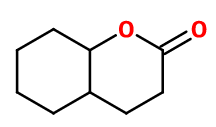
Photo credits: ScenTree SAS
Do you sell any of the raw materials? Would you like to let our users know?
Send an email to fournisseurs@scentree.coto learn about our advertising opportunities.
Do you sell any of the raw materials? Would you like to let our users know?
Send an email to fournisseurs@scentree.coto learn about our advertising opportunities.
General Presentation
-
CAS N° : 4430-31-3
-
EINECS number : 224-623-4
-
FEMA number : 3791
-
FLAVIS number : 13.161
-
JECFA number : 1166
-
Appearance : Colorless liquid
-
Density : 1,09
-
Volatility : Base
-
Price Range : €€€
Physico-chemical properties
-
Molecular formula : C9H14O2
-
Molecular Weight : 154,21 g/mol
-
Log P : 2,52
-
Fusion Point : Donnée indisponible.
-
Boiling Point :
-
Detection Threshold : Donnée indisponible.
-
Optical rotation : Donnée indisponible
-
Vapor pressure : Donnée indisponible
-
Refractive Index @20°C : Donnée indisponible
-
Acid Value : Donnée indisponible.
-
Flash Point : 113°C
Uses
Uses in perfumery :
Octahydrocoumarin is used in fine fragrance in fougere fragrances. Allows to work on fig, coconut, white and heady flowers, vanillic, ambery and spicy-cinnamon notes.
Year of discovery :
Data not available.
Natural availability :
Octahydrocoumarin is not available in its natural state.
Isomerism :
Folione® is a constitutional isomer of Octahydrocoumarin, even if these two ingredient do not have the same smell at all.
Synthesis precursor :
Octahydrocoumarin is not a precursor to the synthesis of another compound of olfactory interest.
Synthesis route :
Octahydrocoumarin is synthesized from Coumarin by a catalytic hydrogenation reaction carried at a high temperature which must reach 392 to 482°F to synthesize this compound. Another synthetic route is an intramolecular esterification of 3-(2-hydroxycyclohexyl)propanoic acid.
Regulations & IFRA
Allergens :
This ingredient does not contain any allergen.
IFRA 51th :
This ingredient is not restricted for the 51th amendment


